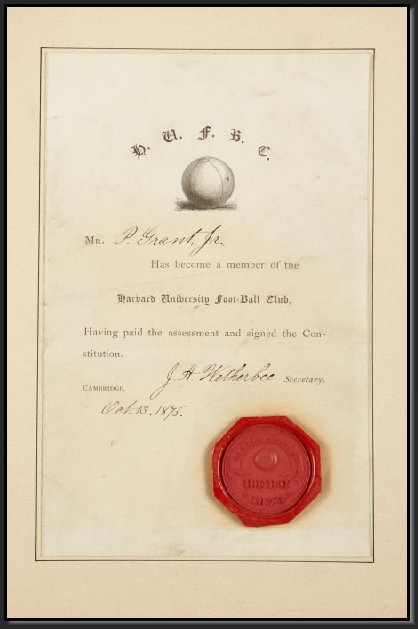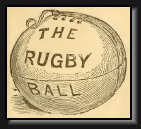Chris Hornung
June 20, 2015
June 20, 2015
For as long as there have been young boys, sport has taught them basic human survival skills. The roots of football are primal; a group working together to obtain something of value and moving it to safety against the threats of a rival. The earliest written accounts of football's predecessors in 11th century England and Ireland describe contests involving hundreds of participants kicking balls toward opposing ends of fields or even towards and against adjacent towns. Without defined rules or referees, the games were notoriously violent and were outlawed in English cities and towns throughout the 14th to 19th century. By the early 19th century, slightly more organized kicking games called fute ball and foote balle grew in popularity, particularly in English grade schools.
The Ball that Shaped the Game...and Vice Versa

In 1863, eleven London football clubs founded the Football Association, marking the divergence point in the evolution of association football (soccer) and rugby. Most clubs that didn't join the Football Association preferred and played the rugby style game. Rugby games between clubs began in 1864, and in 1871 twenty-one clubs founded the Rugby Football Union, which created rules for inter-club play, including the specifications for a standardized rugby ball.
10,000 B.C. - 1850 A.D. Football Origins
1823 A.D. - 1850 A.D.
Rugby School
Rugby School
1650 A.D. - 1865 A.D. Coming to America
In the early 1800's, football had evolved into a kicking game where the use of the hands was prohibited. Whether legend or historical fact, the first recorded instance of a player handling and running with a foot ball was William Webb Ellis at Rugby School in 1823. Considered bad form at the time, the legend goes that a confused Ellis caught a ball in the air and started running towards the opponent's goal. Ellis' knee-jerk reaction eventually made its way into the Rugby School's first written rules of Rugby in 1846 and "rugby" was born.
By the late 1860's, attitudes towards athletic competition began to sway at universities and boarding schools. Headmasters and instructors at these schools that previously condemned sport as time away from study increasingly ascribed to the believe that "strength of character was intertwined with sturdiness of body." (Bundgaard 2005, 27). Games became more organized, and in many cases, were supervised by instructors or masters. As in England in the 1840's and 1850's, each school played by its own distinct rules. Most teams used a mix of Football Association and Rugby Union rules, and the game bore a closer resemblance to full-contact soccer than modern football. Rules could be changed at any time with general agreement of the players.
The first recognized intercollegiate football match took place on November 6, 1869 between Rutgers and the College of New Jersey (later Princeton). The game was played by Rutgers' rules, which allowed 25 players on each team and prohibited any contact with the hands. Rutgers won the game by a score of 6 to 4. Princeton won the rematch played by Princeton's rules, which awarded a player a "try" at goal upon catching the ball, 8-0. Over the next 4 years, Yale, Columbia, Harvard and others formed official teams and played intercollegiate games. Due, in part, to the unfair advantage afforded by playing by the home team's rules, on October 20, 1873, representatives of Rutgers, Columbia, Yale and Princeton met to codify the official Intercollegiate Football rules. The adopted rules were similar to the English Football Association (soccer) rules with the sole means of scoring being kicking the ball in the opponents goal.
The first recognized intercollegiate football match took place on November 6, 1869 between Rutgers and the College of New Jersey (later Princeton). The game was played by Rutgers' rules, which allowed 25 players on each team and prohibited any contact with the hands. Rutgers won the game by a score of 6 to 4. Princeton won the rematch played by Princeton's rules, which awarded a player a "try" at goal upon catching the ball, 8-0. Over the next 4 years, Yale, Columbia, Harvard and others formed official teams and played intercollegiate games. Due, in part, to the unfair advantage afforded by playing by the home team's rules, on October 20, 1873, representatives of Rutgers, Columbia, Yale and Princeton met to codify the official Intercollegiate Football rules. The adopted rules were similar to the English Football Association (soccer) rules with the sole means of scoring being kicking the ball in the opponents goal.
1865 A.D. - 1873 A.D.
Football Becomes Organized
Football Becomes Organized
Woodcut of Soldiers Playing "Foot-Ball", Harper's Weekly, 1863
1874 A.D. - 1876 A.D.
Founding of the Intercollegiate Football Association
Founding of the Intercollegiate Football Association
As with countless other customs, traditions, and technologies, "foot ball" traveled to American shores with her immigrants. As early as the mid-1600's, kicking games were popular with boys in Boston, Massachucetts. By the early 19th century these games had evolved into contests similar to English "mob football" between classes on college campuses at Yale, Princeton, Dartmouth, and Harvard. Rules of play were commonly negotiated by captains at the start of the game. Most accounts describe a free-for-all between dozens or even hundreds of players kicking or hitting a round ball towards and across their opponents goal line. For many, the game was merely a distraction from the brawls that inevitably ensued. As a result, by the early 1860's, football was outlawed on most campuses. The violence and ferocity of these early games is perhaps best illustrated in a 1865 Harper's Weekly woodcut entitled "Holiday in Camp - Soldiers Playing 'Foot-Ball."

America's favorite pastime never stops evolving. Rules are tweaked, playing styles change, athletes get faster and stronger. Every new season brings new players and new innovations. In the sport's early formative years, technological advances in ball manufacturing led to dramatic changes in football, while early 20th century rule changes drove the evolution of today's game ball.
Boston-area football team, circa 1875
Enlargement of round football
Noticeably absent from the 1873 rules committee was Harvard. Representatives of Harvard, who favored a style of play called the "Boston game" that permitted catching and running with the ball, boycotted the meeting out of concern that they would be forced to conform to association football rules.
Spurning the new intercollegiate rules, Harvard turned north for competition, and faced McGill University (Montreal) for a two-game series in May, 1874. Harvard won the first game using Harvard's rules and played to a scoreless draw in the second match using McGill's rugby-based rules. The Harvard players preferred McGill's rugby play over their own and by late 1874 had adopted the style themselves.
The popularity of the rugby style soon spread to other college campuses. In one of the most important moments of American football, on November 23, 1876, Harvard, Columbia, and Princeton formed the Intercollegiate Football Association, which would eventually become the NCAA, and established rules based on the Rugby Football Union rules.
A 1875 Harvard University Foot-Ball Club membership certificate sold by Heritage Auctions in April, 2010 shows a distinctively round football as the club's logo.
Spurning the new intercollegiate rules, Harvard turned north for competition, and faced McGill University (Montreal) for a two-game series in May, 1874. Harvard won the first game using Harvard's rules and played to a scoreless draw in the second match using McGill's rugby-based rules. The Harvard players preferred McGill's rugby play over their own and by late 1874 had adopted the style themselves.
The popularity of the rugby style soon spread to other college campuses. In one of the most important moments of American football, on November 23, 1876, Harvard, Columbia, and Princeton formed the Intercollegiate Football Association, which would eventually become the NCAA, and established rules based on the Rugby Football Union rules.
A 1875 Harvard University Foot-Ball Club membership certificate sold by Heritage Auctions in April, 2010 shows a distinctively round football as the club's logo.
Harvard University Foot-Ball Club Membership Certificate, 1875
Heritage Auctions, April 2010
Heritage Auctions, April 2010

Football Technology Pre-1850
Football Technology - Early 1870's
There is little documentation of the size, shape and materials used for footballs in these early matches. Inflatable leather balls manufactured in England began being imported to the United States in the 1860's. While period photos of 1860's and 1870's foot ball teams are extremely rare, those that do exist show players with distinctly round balls similar in proportion to a modern basketball.

Oldest known football, circa 1550
Stirling's Smith Museum
Stirling's Smith Museum
17th century print of football being inflated
Pig's Bladder
Richard Lindon, circa 1880.
The Evolution of the Football








